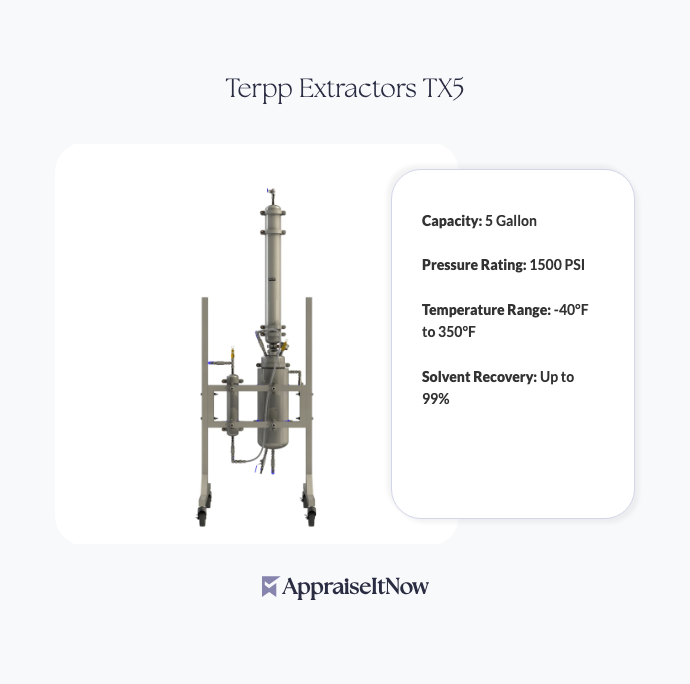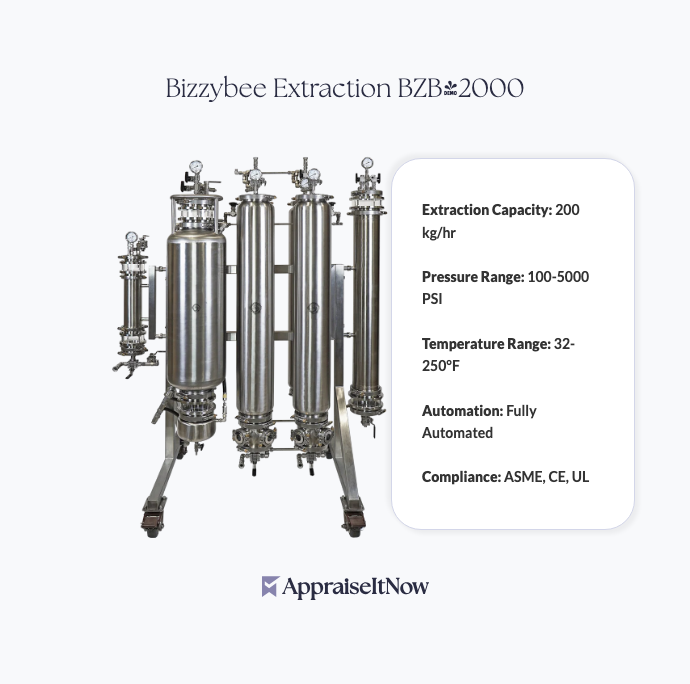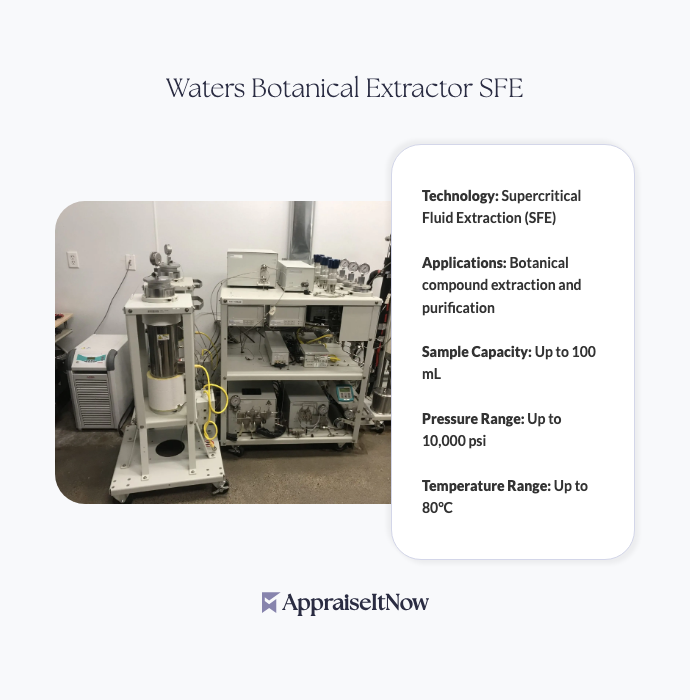<h1>How to Get Your Pure5 Extraction 20L System Appraised</h1>
<p>The Pure5 Extraction 20L System represents a significant capital investment for commercial cannabis and botanical processors. With current market values ranging from <strong>$340,000 to $430,000</strong>, understanding how to properly appraise this sophisticated equipment ensures you make informed decisions whether you're buying, selling, insuring, or managing this asset for business purposes.</p>
<h2>Understanding Your Pure5 System's Market Position</h2>
<p>The Pure5 Extraction 20L System stands as a leading choice in commercial extraction technology, deployed across over 100 commercial facilities worldwide. Since its introduction in 2018, this closed-loop extraction system has earned a reputation for exceptional reliability and output quality. Your system's value depends on several interconnected factors that professional appraisers carefully evaluate.</p>
<p>The equipment's capability to produce 99.9% purity extracts with daily processing capacity up to 200 lbs makes it highly sought after in the <a href="/types/cannabis-equipment">cannabis equipment</a> market. This isn't just about raw processing power—the system's cGMP compliance, patented closed-loop design, and energy-efficient operation significantly influence its appraised value, particularly for businesses using equipment in revenue-generating operations where the income approach to valuation becomes relevant.</p>
<h2>Key Factors Affecting Your Pure5 Extraction 20L System's Appraisal</h2>
<p>Several primary factors substantially impact what your Pure5 system is worth today. <strong>Age and acquisition date</strong> matter considerably—a system purchased in 2018 trades differently than one acquired last year. <strong>Operating hours and maintenance history</strong> directly correlate with remaining useful life; systems with meticulous maintenance records and lower run-hours command premium valuations. <strong>Equipment condition</strong>, including wear on critical components like the extraction vessel, automated controls, and closed-loop mechanism, receives detailed assessment during professional appraisal.</p>
<p>The presence of <strong>included accessories and ancillary systems</strong> can shift valuations by 10-20%. If your Pure5 comes bundled with dedicated chillers, vacuum pumps, or solvent recovery systems, these substantially increase total asset value. Documentation proving serial number authenticity, calibration certificates, and original purchase invoices strengthens appraisal findings and supports higher valuations.</p>
<div class="callout tip"><p><strong>Appraiser's Insight</strong></p>
<p>Systems with documented maintenance logs showing regular calibration and component replacement maintain stronger resale values than equipment with sparse documentation, even if physically identical.</p></div>
<h2>Regulatory Compliance and Market Saleability</h2>
<p>Your Pure5 Extraction 20L System's value extends beyond mechanical specifications to include regulatory positioning. The equipment's <strong>cGMP manufacturing standard compliance</strong> makes it suitable for both hemp and cannabis operations across varying state jurisdictions, expanding its potential buyer pool. However, <strong>state-level legal restrictions</strong> and local permit requirements can substantially affect marketability and timing for resale—a system that's immediately transferable in one state might face 6-12 month delays in another.</p>
<p>Understanding how compliance certifications impact value requires professional expertise. Systems meeting cGMP, CE, and UL standards carry documented proof of safety and regulatory alignment. When working with appraisers through platforms like <strong>AppraiseItNow</strong>, specialists familiar with the cannabis industry understand how these certifications translate directly to both marketability and fair market value determinations.</p>
<p>The question of regulatory transfer restrictions deserves serious consideration during appraisal. Some states impose facility-specific licensing tied to equipment registration, potentially limiting who can legally operate your Pure5 system. Professional appraisers account for these restrictions when establishing value, often distinguishing between unrestricted units and those with regulatory encumbrances that reduce the potential buyer pool.</p>
<h2>Valuation Methodologies for Specialized Extraction Equipment</h2>
<p>Professional appraisals of your Pure5 Extraction 20L System typically employ three complementary valuation approaches, with the relative emphasis depending on your specific situation. The <strong>cost approach</strong> establishes replacement value for a new equivalent system—currently approximately <strong>$450,000 to $550,000</strong> for a new Pure5 unit with standard configuration. This provides an upper baseline, with depreciation calculated based on age, condition, and technological advancement.</p>
<p>The <strong>sales comparison approach</strong> analyzes actual market transactions for comparable used extraction systems. Unlike publicly traded equipment where price discovery is simple, the cannabis equipment market operates through private sales, direct dealers, and specialized brokers. Professional appraisers maintain databases of recent arms-length sales, used system listings, and dealer quotes to establish what your specific Pure5 system would realistically command in current market conditions.</p>
<p>For equipment actively generating revenue, the <strong>income approach</strong> becomes particularly relevant. If your Pure5 system operates in a commercial extraction facility, appraisers can evaluate the equipment's value based on income-generating capacity, considering factors like extraction yield rates, product quality premiums, and facility utilization rates. This approach often applies when equipment serves as collateral for financing or when businesses evaluate asset productivity for operational decisions.</p>
<div class="callout note"><p><strong>Methodology Insight</strong></p>
<p>The income approach frequently supports higher valuations for well-utilized equipment in operating facilities, reflecting the equipment's revenue-generating capacity rather than just replacement cost.</p></div>
<h2>Documentation Requirements for Accurate Appraisal</h2>
<p>To maximize accuracy and defensibility of your Pure5 system's appraisal, compile comprehensive documentation before engaging appraisers. The <strong>serial number</strong> and manufacturer verification prove authenticity and allow appraisers to confirm specifications and manufacturing date. <strong>Maintenance logs</strong> documenting component replacements, calibration records, and service history provide objective evidence of system care and remaining useful life.</p>
<p><strong>Calibration certificates</strong> from qualified technicians validate that your system operates within manufacturing specifications, which directly supports premium valuation. The <strong>original purchase invoice</strong> establishes acquisition date, initial cost baseline, and equipment configuration details. <strong>Operating manuals and technical documentation</strong> help appraisers understand system complexity and specialized features that affect market positioning compared to competitive extraction systems.</p>
<p>Documentation also includes <strong>permits and compliance certifications</strong>, state registration numbers, and any facility-specific licenses tied to equipment operation. While these regulatory documents sometimes impose transfer restrictions, they also prove legitimate legal operation and regulatory standing—factors that responsible buyers and lenders increasingly demand before acquisition.</p>
<h2>Understanding Market Liquidity and Sale Timeline Expectations</h2>
<p>The used market for large extraction systems like your Pure5 20L operates differently than commodity equipment markets with published pricing and rapid transactions. <strong>Typical lead times for finding qualified buyers range from 3-8 months</strong>, depending on equipment condition, facility location, and current market demand. Systems in top condition with exceptional documentation often sell within 4-6 months, while units requiring deferred maintenance or lacking documentation may require 8-12 months.</p>
<p>Price discounts from new equipment typically range from <strong>15-30%</strong> for well-maintained two to three-year-old systems, with steeper discounts for older equipment or units requiring facility-specific modifications for new locations. Understanding these realistic market parameters helps you evaluate whether holding the equipment for future appreciation makes financial sense versus converting it to liquidity now.</p>
<p>Geographic location significantly affects sales velocity. Equipment in regions with established cannabis industries and multiple active processors finds buyers more readily than systems in jurisdictions with limited extraction operations or regulatory uncertainty. Professional appraisers can discuss regional market dynamics and provide guidance on optimal timing for equipment disposition.</p>
<h2>Professional Appraisal Fees and Service Timeline</h2>
<p><strong>Appraisal costs for equipment in the $300,000–$400,000 range typically run $2,000 to $4,000</strong>, depending on system complexity, documentation completeness, and whether physical inspection proves necessary. <strong>Turnaround times for certified reports generally range from 10-15 business days</strong> following equipment inspection and document review, though rush services are sometimes available for additional fees.</p>
<p>When selecting an appraisal provider, look for specialists with documented cannabis equipment experience and professional certifications from recognized appraisal organizations (AAA, ISA, ASA, CAGA, AMEA). Services like <strong>AppraiseItNow</strong> connect you with credentialed appraisers across the U.S. who understand both general equipment valuation principles and cannabis industry-specific factors affecting Pure5 system values.</p>
<p>The appraisal process typically includes physical inspection of the equipment, detailed photography documenting condition and markings, serial number verification, documentation review, and comparative market analysis. Professional appraisers can advise on whether your specific situation warrants inspection versus desktop appraisal based on documentation quality and the purpose driving the valuation need.</p>
<h2>Appraisal Report Standards and End-User Requirements</h2>
<p>The structure and content of your appraisal report should satisfy multiple stakeholders depending on your situation. <strong>USPAP-compliant reports</strong> acceptable to lenders, insurers, and legal proceedings follow standardized formats including detailed value conclusions, methodology explanations, and limiting conditions. If you need appraisal documentation for <strong>insurance purposes</strong>, the report should establish replacement value and document condition for coverage determination.</p>
<p>For <strong>lending transactions</strong>, appraisers provide reports meeting lender specifications, often including collateral valuation and exposure analysis. <strong>Estate or divorce proceedings</strong> require appraisals following specific legal standards in your jurisdiction, with particular attention to asset marketability and fair market value conclusions supportable under professional scrutiny. When considering <a href="/blog/the-basics-of-equipment-and-machinery-appraisal">specialized equipment valuation</a>, understanding your end-use requirements helps appraisers structure reports appropriately.</p>
<p>Professional appraisal reports include certification statements affirming the appraiser's qualifications, independence, and adherence to professional standards. This documentation becomes essential when valuations face questioning during insurance claims, legal proceedings, or financial audits.</p>
<h2>Ensuring Verification and Defensibility</h2>
<p>Qualified appraisers perform specific verification steps that ensure accuracy and defensibility of Pure5 Extraction 20L System valuations. <strong>Serial number verification</strong> confirms equipment authenticity and matches manufacturer records to documented specifications. <strong>Functional testing</strong> of critical system components—even for equipment not currently operational—validates condition assessments and supports conclusions about remaining useful life.</p>
<p><strong>Photographic documentation</strong> from multiple angles captures equipment condition, major components, and any visible wear or modifications. These photographs become invaluable reference materials if valuations face subsequent questioning or if you're documenting condition for insurance purposes. <strong>Comparative analysis</strong> of recent market transactions for similar equipment establishes value reasonableness through market-supported conclusions rather than subjective assessments.</p>
<p>When equipment has undergone modifications or repairs, appraisers document these changes and evaluate impact on value and function. This transparency in appraisal processes protects both appraisers and equipment owners by creating defensible, well-documented value conclusions. For businesses relying on <a href="/blog/appraising-industrial-equipment-assessing-machinery-and-manufacturing-assets">heavy machinery and equipment valuations</a>, this documentation discipline proves critical.</p>
<div class="callout tip"><p><strong>Documentation Best Practice</strong></p>
<p>Maintain photographs of your Pure5 system in operational condition, ideally showing product output and facility integration, as these help appraisers understand actual revenue-generating deployment.</p></div>
<h2>Transferability and Legal Considerations</h2>
<p>Before pursuing sale or financing against your Pure5 system, understand the legal landscape affecting transferability. <strong>State-specific registration requirements</strong> may tie equipment to your current facility license, requiring state approval before transfer to new ownership. Some states impose <strong>resale restrictions</strong> requiring that equipment remain in licensed facilities, effectively limiting your buyer pool to other licensed operators.</p>
<p><strong>Facility-specific modifications</strong> made to your Pure5 system can substantially reduce market value if the modifications don't transfer to new locations. Equipment configured for specific solvent types, integrated into custom facility layouts, or modified for particular cannabinoid profiles may prove difficult for potential buyers to repurpose. Understanding these limitations during appraisal helps establish realistic valuations reflecting actual marketability rather than theoretical replacement cost.</p>
<p>Professional appraisers familiar with cannabis industry regulations help identify transferability issues and factor these into value conclusions. This expertise prevents unpleasant surprises when you attempt to sell or finance equipment, as legal encumbrances directly impact marketability and, therefore, fair market value.</p>
<h2>Making Informed Decisions with Professional Appraisal</h2>
<p>Whether you're evaluating your Pure5 Extraction 20L System for purchase, sale, insurance, or financing purposes, professional appraisal provides objective, defensible value conclusions grounded in current market data and industry expertise. The system's <strong>$340,000 to $430,000 valuation range</strong> reflects strong equipment demand among commercial processors, but your specific system's value depends on condition, documentation, regulatory status, and market timing factors that only detailed professional analysis can properly address.</p>
<p>Engaging certified appraisers through <strong>AppraiseItNow</strong> ensures you receive USPAP-compliant valuations suitable for lending, insurance, litigation, or sale purposes. These experts understand both the sophisticated technical specifications that make your Pure5 system valuable and the cannabis industry regulatory environment affecting marketability and transfer logistics.</p>
<p>Taking the time to compile comprehensive documentation—maintenance records, calibration certificates, purchase invoices, and serial number verification—before engaging appraisers strengthens the appraisal process and often supports more favorable value conclusions. This preparation also accelerates the appraisal timeline and reduces overall costs by minimizing appraiser investigation and documentation hunting.</p>
<div class="callout note"><p><strong>Key Takeaway</strong></p>
<p>A certified appraisal of your Pure5 Extraction 20L System provides the objective, defensible value documentation you need for confident buying, selling, insuring, or financing decisions. Professional appraisers bring both specialized equipment expertise and cannabis industry knowledge, ensuring your valuation reflects actual market conditions and regulatory realities affecting this sophisticated extraction technology.</p></div>







.avif)







